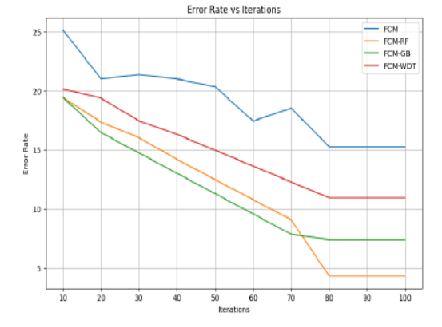


Indian Journal of Science and Technology
DOI: 10.17485/IJST/v17i23.1203
Year: 2024, Volume: 17, Issue: 23, Pages: 2390-2400
Original Article
P S S Akilashri1, G Nithya2∗
1Head of the Department, Department of Computer Science, National College, Tiruchirappalli, Tamil Nadu, India
2Research Scholar, Department of Computer Science, National College, Tiruchirappalli, Tamil Nadu, India
*Corresponding Author
Email: [email protected]
Received Date:10 April 2024, Accepted Date:17 May 2024, Published Date:03 June 2024
Background/Objectives: The COVID-19 pandemic has created an urgent need for rapid and accurate diagnosis to facilitate timely treatment and control spread. However, the initial symptoms can be non-specific, making early differential diagnosis challenging. Methods: This study proposes an integrated framework for COVID-19 diagnosis using improved Fuzzy Cognitive Map (FCM) approach for fast, intelligent screening of COVID-19 cases versus other respiratory conditions based on risk factors and clinical presentation. The integrated framework is designed based on combining fuzzy cognitive maps with different classifiers separately such as Random Forest (RF) classifier, Gradient Boosting (GB) classifier and Weighted Decision Tree (WDT) approach to model interrelationships between indicative symptoms and risk factors in COVID-19. The model is evaluated on a real time COVID-19 dataset of 600 patient details (i.e., 520 non-covid and 80 Covid). Due to the unbalanced nature of class labels, this work is evaluated based on balanced accuracy and Matthews’s correlation coefficient to identify the appropriate model. Findings: Among the different combination of classifiers FCM-RF attains 95.91% which outperforms 15.14%, 5.05% and 7.69% higher than normal FCM, FCM-GB and FCM-WDT. Novelty: The interpretability of the fuzzy map supplemented by the high predictive performance of random forest provides an effective decision support system for frontline healthcare workers to make quick, reliable screening decisions and ensure optimal care pathways. The integrated approach demonstrates the potential of computational intelligence in addressing critical diagnosis challenges within complex, urgent medical scenarios.
Keywords: COVID-19, Ensemble Approach, Improved fuzzy cognitive maps, Balanced accuracy, Clinical dataset
© 2024 Akilashri & Nithya. This is an open-access article distributed under the terms of the Creative Commons Attribution License, which permits unrestricted use, distribution, and reproduction in any medium, provided the original author and source are credited. Published By Indian Society for Education and Environment (iSee)
Subscribe now for latest articles and news.